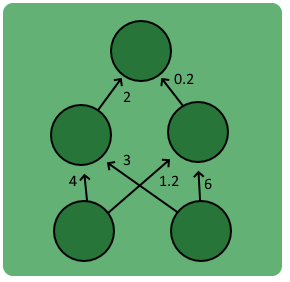We can create a word graph based on a sentence, a document or a dataset. Here is the tutorial:
An Introduction to Build a Word Graph From a Document or Dataset
However, how to determine the different weight between words in this word graph? This paper: VGCN-BERT: Augmenting BERT with Graph Embedding for Text Classification proposed a method.
Word Weighted Grpah
A word weighted graph looks like:

Each node is a word.
Normalized Point-wise Mutual Information (NPMI)
NPMI is proposed to compute the weight between words based on word co-occurrences in the same sentence. It is defined as follows:
\[NPMI(i,j)=-\frac{1}{\log_{}{p(i,j)}}\log\frac{p(i,j)}{p(i)p(j)}\]
where \(i\) and \(j\) are words, \(p(i,j) = \frac{\sharp W(i,j)}{\sharp W}\), \(p(i) = \frac{\sharp W(i)}{\sharp W}\), \(\sharp W(*)\) is the number of sliding windows containing a word or a pair of words, and \(\sharp W\) is the total
number of sliding windows. To obtain long-range dependency, we set the window to the whole sentence.
Notice: in some papers, the window size may be 2 or 3.
How to determine the correlation based on a threshold?
The range of value of NPMI is [-1,1]. A positive NPMI value implies a high semantic correlation between words, while a negative NPMI value indicates little or no semantic correlation. In our approach, we create anedge between two words if their NPMI is larger than a threshold. Our experiments show that the performance is better when the threshold is between 0.0and 0.3. From this paper, we can find 0.2 threshold can be used.